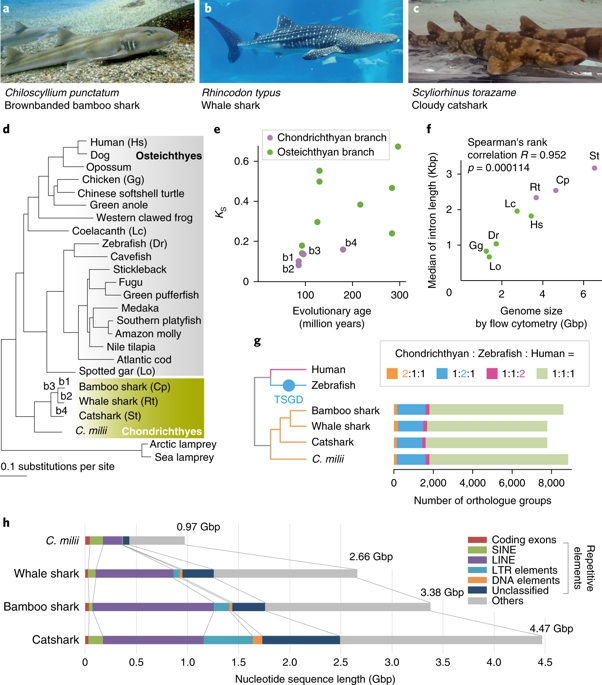サメ類のゲノム解析がもたらした板鰓類の進化と脊椎動物の起源に関する手掛かり OPEN
Shark genomes provide insights into elasmobranch evolution and the origin of vertebrates
2018年10月8日 Nature Ecology & Evolution 2 : 10 doi: 10.1038/s41559-018-0673-5

現生軟骨魚類は板鰓類(サメ類とエイ類)とギンザメ類に分類される。板鰓類については高精度の全ゲノム塩基配列が得られておらず、そのため脊椎動物の初期進化や板鰓類に特有の表現型についての理解が進んでいない。本論文では、イヌザメおよびトラザメの新規の全ゲノムアセンブリと、ジンベエザメの改良版ゲノムアセンブリを報告する。これら3種の比較的大型のゲノム(3.8~6.7 Gbp)にはタンパク質コード遺伝子や転写制御領域がまばらに分布しており、また、分子進化速度が低下していたことが読み取れる。サメ類のゲノムを綿密に解析することにより、これまで失われたと考えられていたHox C遺伝子群が保持されていることが明らかになり、独特なニッチへの適応に関連すると思われるオプシンおよび嗅覚受容体の特徴ある遺伝子レパートリーも見いだされた。哺乳類の恒常性や繁殖を制御する遺伝子セットが有顎脊椎動物の祖先の段階ですでに確立されていたことも明らかになった。ゲノムだけでなくトランスクリプトームやエピゲノムの情報リソースに基づいた本研究の成果は、サメ類に特有の表現型を分子レベルで包括的に探るための基盤となるとともに、脊椎動物の進化的起源に関する手掛かりをもたらす。
【 関連コンテンツ 】
Scientific Data | Data Descriptor | OPEN
Embryonic transcriptome sequencing of the ocellate spot skate Okamejei kenojei
Scientific Data | Data Descriptor | OPEN
A de novo transcriptome assembly of the zebra bullhead shark, Heterodontus zebra
Corresponding Author
Modern cartilaginous fishes are divided into elasmobranchs (sharks, rays and skates) and chimaeras, and the lack of established whole-genome sequences for the former has prevented our understanding of early vertebrate evolution and the unique phenotypes of elasmobranchs. Here we present de novo whole-genome assemblies of brownbanded bamboo shark and cloudy catshark and an improved assembly of the whale shark genome. These relatively large genomes (3.8–6.7 Gbp) contain sparse distributions of coding genes and regulatory elements and exhibit reduced molecular evolutionary rates. Our thorough genome annotation revealed Hox C genes previously hypothesized to have been lost, as well as distinct gene repertories of opsins and olfactory receptors that would be associated with adaptation to unique underwater niches. We also show the early establishment of the genetic machinery governing mammalian homoeostasis and reproduction at the jawed vertebrate ancestor. This study, supported by genomic, transcriptomic and epigenomic resources, provides a foundation for the comprehensive, molecular exploration of phenotypes unique to sharks and insights into the evolutionary origins of vertebrates.

